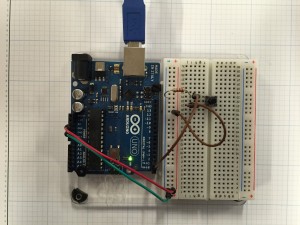This week we started to use the Arduino to input and output analog signals.
Beginning with a simple pushbutton to turn on an LED:
void setup() {
pinMode(2, INPUT); // set the switch pin to be an input
pinMode(3, OUTPUT); // set the yellow LED pin to be an output
pinMode(4, OUTPUT); // set the red LED pin to be an output
}
void loop() {
// read the switch input:
if (digitalRead(2) == HIGH) {
// if the switch is closed:
digitalWrite(3, HIGH); // turn on the yellow LED
digitalWrite(4, LOW); // turn off the red LED
}
else {
// if the switch is open:
digitalWrite(3, LOW); // turn off the yellow LED
digitalWrite(4, HIGH); // turn on the red LED
}
}
Next we worked with analog inputs:
const int ledPin = 9; // pin that the LED is attached to
int analogValue = 0; // value read from the pot
int brightness = 0; // PWM pin that the LED is on.
void setup() {
// initialize serial communications at 9600 bps:
Serial.begin(9600);
// declare the led pin as an output:
pinMode(ledPin, OUTPUT);
}
void loop() {
analogValue = analogRead(A0); // read the pot value
brightness = analogValue /4; //divide by 4 to fit in a byte
analogWrite(ledPin, brightness); // PWM the LED with the brightness value
Serial.println(brightness); // print the brightness value back to the serial monitor
}
Here is the code outputting to a potentiometer:
And here it is with a CdS Photoresistor:
Finally I decided to work a little with outputting pulse width modulation to an LED, controlled via a sliding pot. Here is the simple code:
const int potPin = A0;
const int ledPin = 3;
int sensor = 0;
int output = 0;
void setup() {
}
void loop() {
sensor = analogRead(potPin);
output = map(sensor, 0, 1023, 0, 255);
analogWrite(ledPin, output);
}
Here is what it looks like on my oscilloscope while “dimming” 🙂
